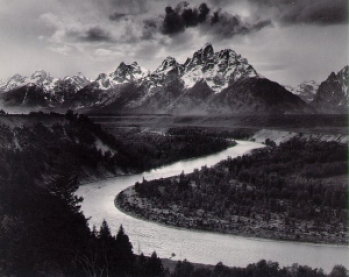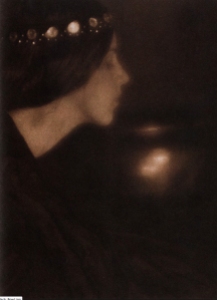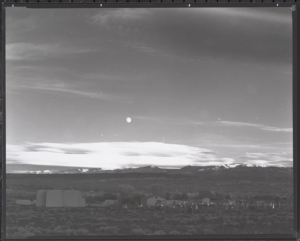Ansel Adams (1902 – 1984)
(Fifth in a series of six articles)
First, it needs to be noted I am not making a comparison between my photography work or skills to that of Ansel Adams. He is the subject here simply because of his popularity the admiration so many share for his popular works of art . I greatly admire his photographs as does most of the professional photographic community today.
Radical may be too strong of a word for Ansel Adams and his small group of photographer friends in the early 1930’s but they did represent an opposite view of photography than what was generally accepted at the time. This group of seven California photographers formed Group f/64 as an opposing point of view from the dominating New York pictorialist photographers of the time such as Alfred Stieglitz.
Group f/64’s photos represented sharp focused and carefully framed photos vs. the pictorialists who felt photography should emulate a painting or etching and used soft focus techniques, heavy manipulation in the darkroom and exotic printing processes to attain this style. The two top photographs, by Edward Weston (left) and Ansel Adams (right), represent Group f/64 vs. the pictoralists style of the time shown on the bottom row.

Bell Pepper #30 1930 by Edward Weston

Snake River and Tetons by Ansel Adams
Scan courtesy of Masters of Photography
© Center for Creative Photography, Arizona Board of Regents

The Black Bowl by George Seeley

Snapshot Paris by Alfred Steigletz
While it was the goal of Group f/64 to show more realistic photography that does not mean that Ansel Adams or other members of the group never altered their photos in the darkroom. It was asked of Ansel Adams,
Once the photograph is taken, is the development and printing a mechanical process?
No, it is not mechanical. Although there is a procedure, there is much judgment involved on the part of the artist. Ansel said that the negative for Moonrise was difficult to print. He tried many methods using different chemicals and times and papers. With the negative in the enlarger, he increased the light hitting certain areas (burning-in) which made the sky blacker and the clouds less bright so the moon would stand out more. With all these artistic adjustments, Adams said “it is safe to say that no two prints are precisely the same.”
Housatonic Museum of Art, Housatonic Community College Bridgeport, CT
And here is a quote from “Ansel Adams: Some Thoughts About Ansel And About Moonrise”
“Moonrise was Ansel’s most difficult negative of all to print. Using simple pieces of cardboard, Ansel would painstakingly burn in (darken with additional light from the enlarger) the sky, which was really quite pale with streaks of cloud throughout. He was careful to hold back a bit on the moon. The mid-ground was dodged (light withheld), though the crosses have been subtly burned in. This process took Ansel more than two minutes per print of intricate burning and dodging. Ansel created Moonrise with a night sky, a luminous moon and an extraordinary cloud bank that seems to reflect the moon’s brilliance. Moonrise is sleight of hand. Moonrise is magic.”
What Ansel Adams and others are describing can clearly be seen in the photos below. The photo on the left is the photo printed with none of Ansel Adams’ darkroom magic. Some would call this manipulation. The clouds have been darkened bringing back some detail, the foreground has been lightened bringing more detail to this section and entire sky has been blackened resulting in entire clouds disappearing. The result is a much more dramatic photograph. Further, the photo on the right below is also a very different interpretation than those photos of “Moonrise” printed before 1949 when the image was lighter overall.

Ansel Adams Moonrise Over Hernandez Contact Print

Ansel Adams Moonrise Over Hernandez
Moonrise, Hernandez, New Mexico 1941 ©The Trustees of the Ansel Adams Publishing Rights Trust
Scan courtesy of Masters of Photography
Ansel Adams used all of the modern tools available to him, including the most innovative darkroom techniques of the day. If he were alive today, it is my sincere belief that he would be using the highest quality digital cameras and computer software to produce the best images possible.
Professional photographers all make decisions regarding the acceptable level of creative license we take with each image we print. For an image to be free of manipulation, it would have to be void of all filters, flashes, selection of special film known for recording bright colors such as Fuji Velvia. The only lens that would be allowed would be the 50mm normal lens, no wide-angle lens or telephoto lenses. No dodging (lightening sections of the image) or burning (darkening sections of the image) would be allowed. Would black and white be allowed? After all, we do not see the world in black and white….. We would be left with photos so bland they would be of little interest to anyone. Altering photographic images is necessary part of digital photography. Photography is an art form. The level of manipulations is up to each artist. For me, I strive to have the final image look as realistic as possible, bringing out details in shadows and highlights and otherwise bring the photo to life as I remember it. To print a photo totally void of any alterations is not a goal digital photographers seek. When photographers create something that is not possible, they need to clearly advise all of these manipulations. Some images, especially HDR images today, are so far from the norm, it is obvious to all they are enhanced. It is, after all, art.
Photo Permissions:
Ansel Adams; “Grand Tetons and the Snake River” image is available from the Archival Research Catalog of the National Archives and Records Administration under the ARC Identifier 519904. Ansel Adams took this photograph while employed by the United States Government, see http://www.archives.gov/research/ansel-adams/ for more information
George Seeley; “The Black Bowl.” This media file is in the Public Domain in the United States. This applies to US works where the copy right has expired often because the first publication occurred prior to January 1, 1923.
Alfred Steglitz, “A Snapshot of Paris.” This media file is in the Public Domain in the United States. This applies to US works where the copy right has expired often because the first publication occurred prior to January 1, 1923.

Pingback: Storm Clouds in Monochrome - S. W. Krull Imaging